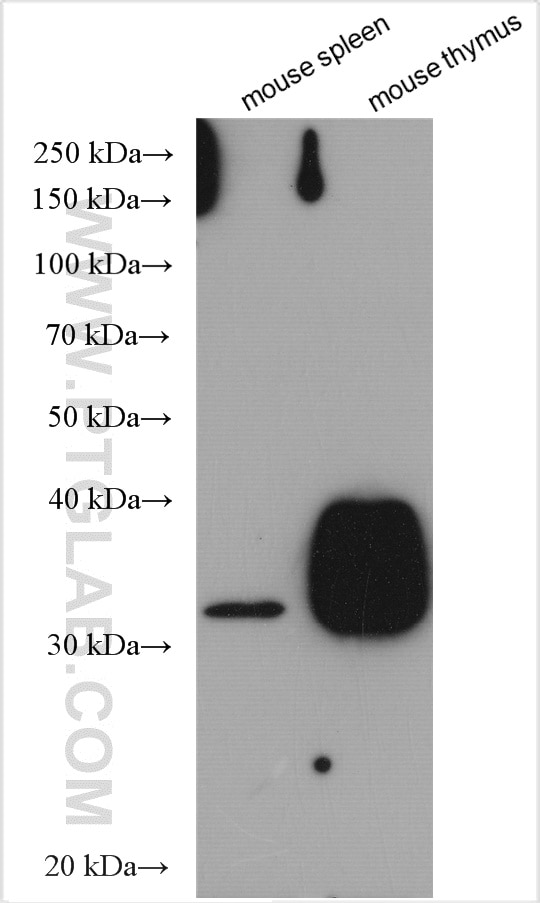Anticorps Polyclonal de lapin anti-CD8a
CD8a Polyclonal Antibody for WB, IF-Fro, ELISA
Hôte / Isotype
Lapin / IgG
Réactivité testée
souris et plus (1)
Applications
WB, IF-Fro, ELISA
Conjugaison
Non conjugué
N° de cat : 29896-1-AP
Synonymes
Galerie de données de validation
Applications testées
| Résultats positifs en WB | tissu splénique de souris, tissu de thymus de souris |
| Résultats positifs en IF-Fro | tissu splénique de souris, |
Dilution recommandée
| Application | Dilution |
|---|---|
| Western Blot (WB) | WB : 1:1000-1:5000 |
| Immunofluorescence (IF)-FRO | IF-FRO : 1:50-1:500 |
| It is recommended that this reagent should be titrated in each testing system to obtain optimal results. | |
| Sample-dependent, check data in validation data gallery | |
Applications publiées
| WB | See 1 publications below |
| IF | See 6 publications below |
Informations sur le produit
29896-1-AP cible CD8a dans les applications de WB, IF-Fro, ELISA et montre une réactivité avec des échantillons souris
| Réactivité | souris |
| Réactivité citée | Humain, souris |
| Hôte / Isotype | Lapin / IgG |
| Clonalité | Polyclonal |
| Type | Anticorps |
| Immunogène | CD8a Protéine recombinante Ag31942 |
| Nom complet | CD8 antigen, alpha chain |
| Masse moléculaire calculée | 27KD |
| Poids moléculaire observé | 32-35 kDa |
| Numéro d’acquisition GenBank | NM_001081110 |
| Symbole du gène | Cd8a |
| Identification du gène (NCBI) | 12525 |
| Conjugaison | Non conjugué |
| Forme | Liquide |
| Méthode de purification | Purification par affinité contre l'antigène |
| Tampon de stockage | PBS with 0.02% sodium azide and 50% glycerol |
| Conditions de stockage | Stocker à -20°C. Stable pendant un an après l'expédition. L'aliquotage n'est pas nécessaire pour le stockage à -20oC Les 20ul contiennent 0,1% de BSA. |
Informations générales
CD8 is a transmembrane glycoprotein that is predominantly expressed on the surface of cytotoxic T cells, and can also be found on natural killer cells, cortical thymocytes, and dendritic cells. CD8 is composed of two disulfide-linked chains and can be present as a homodimer of CD8α or as a heterodimer of CD8α and CD8β (PMID: 3264320; 8253791). The majority of class I-restricted T cells express mostly the CD8αβ heterodimer while CD8αα homodimers alone have been found on some gut intraepithelial T cells , on some T cell receptor (TCR) γδ T cells and on NK cells (PMID: 2111591; 1831127; 8420975). CD8 acts as a co-receptor that binds to MHC class-I and participates in cytotoxic T cell activation (PMID: 8499079). During T cell development, CD8 is required for positive selection of CD4-/CD8+ T cells (PMID: 1968084).
Protocole
| Product Specific Protocols | |
|---|---|
| WB protocol for CD8a antibody 29896-1-AP | Download protocol |
| IF protocol for CD8a antibody 29896-1-AP | Download protocol |
| Standard Protocols | |
|---|---|
| Click here to view our Standard Protocols |
Publications
| Species | Application | Title |
|---|---|---|
J Nanobiotechnology Oxygen-delivery nanoparticles enhanced immunotherapy efficacy monitored by granzyme B PET imaging in malignant tumors | ||
Front Immunol Machine learning-based identification of tumor-infiltrating immune cell-associated model with appealing implications in improving prognosis and immunotherapy response in bladder cancer patients | ||
Int Immunopharmacol Triggering receptor expressed on myeloid cells-1 aggravates obliterative bronchiolitis via enhancing the proinflammatory phenotype of macrophages | ||
Bioorg Chem Synthesis and immunotherapy efficacy of a PD-L1 small-molecule inhibitor combined with its 131I-iodide labelled isostructural compound | ||
Int J Pharm X Topical transdermal administration of lenalidomide nanosuspensions-based hydrogels against melanoma: In vitro and in vivo studies | ||
J Transl Med Escherichia coli combination with PD-1 blockade synergistically enhances immunotherapy in glioblastoma multiforme by regulating the immune cells |



